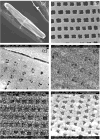Detecting explosive molecules from nanoliter solution: A new paradigm of SERS sensing on hydrophilic photonic crystal biosilica
- PMID: 27471144
- PMCID: PMC5371024
- DOI: 10.1016/j.bios.2016.07.062
Detecting explosive molecules from nanoliter solution: A new paradigm of SERS sensing on hydrophilic photonic crystal biosilica
Abstract
We demonstrate a photonic crystal biosilica surface-enhanced Raman scattering (SERS) substrate based on a diatom frustule with in-situ synthesized silver nanoparticles (Ag NPs) to detect explosive molecules from nanoliter (nL) solution. By integrating high density Ag NPs inside the nanopores of diatom biosilica, which is not achievable by traditional self-assembly techniques, we obtained ultra-high SERS sensitivity due to dual enhancement mechanisms. First, the hybrid plasmonic-photonic crystal biosilica with three dimensional morphologies was obtained by electroless-deposited Ag seeds at nanometer sized diatom frustule surface, which provides high density hot spots as well as strongly coupled optical resonances with the photonic crystal structure of diatom frustules. Second, we discovered that the evaporation-driven microscopic flow combined with the strong hydrophilic surface of diatom frustules is capable of concentrating the analyte molecules, which offers a simple yet effective mechanism to accelerate the mass transport into the SERS substrate. Using the inkjet printing technology, we are able to deliver multiple 100pico-liter (pL) volume droplets with pinpoint accuracy into a single diatom frustule with dimension around 30µm×7µm×5µm, which allows for label-free detection of explosive molecules such as trinitrotoluene (TNT) down to 10-10M in concentration and 2.7×10-15g in mass from 120nL solution. Our research illustrates a new paradigm of SERS sensing to detect trace level of chemical compounds from minimum volume of analyte using nature created photonic crystal biosilica materials.
Keywords: Diatom biosilica; Hydrophilic surface; Inkjet printing; Photonic crystal; Surface-enhanced Raman scattering.
Copyright © 2016 Elsevier B.V. All rights reserved.
Figures






Similar articles
-
Chemical and Biological Sensing Using Diatom Photonic Crystal Biosilica With In-Situ Growth Plasmonic Nanoparticles.IEEE Trans Nanobioscience. 2016 Dec;15(8):828-834. doi: 10.1109/TNB.2016.2636869. Epub 2016 Dec 7. IEEE Trans Nanobioscience. 2016. PMID: 27959817 Free PMC article.
-
Photoluminescence detection of 2,4,6-trinitrotoluene (TNT) binding on diatom frustule biosilica functionalized with an anti-TNT monoclonal antibody fragment.Biosens Bioelectron. 2016 May 15;79:742-8. doi: 10.1016/j.bios.2016.01.002. Epub 2016 Jan 4. Biosens Bioelectron. 2016. PMID: 26774089
-
Ultra-sensitive immunoassay biosensors using hybrid plasmonic-biosilica nanostructured materials.J Biophotonics. 2015 Aug;8(8):659-67. doi: 10.1002/jbio.201400070. Epub 2014 Sep 25. J Biophotonics. 2015. PMID: 25256544 Free PMC article.
-
Photonic Nano-/Microstructured Diatom Based Biosilica in Metal Modification and Removal-A Review.Materials (Basel). 2022 Sep 23;15(19):6597. doi: 10.3390/ma15196597. Materials (Basel). 2022. PMID: 36233939 Free PMC article. Review.
-
Diatoms: self assembled silica nanostructures, and templates for bio/chemical sensors and biomimetic membranes.Analyst. 2011 Jan 7;136(1):42-53. doi: 10.1039/c0an00602e. Epub 2010 Oct 7. Analyst. 2011. PMID: 20931107 Review.
Cited by
-
Quantitative TLC-SERS detection of histamine in seafood with support vector machine analysis.Food Control. 2019 Sep;103:111-118. doi: 10.1016/j.foodcont.2019.03.032. Epub 2019 Apr 3. Food Control. 2019. PMID: 31827314 Free PMC article.
-
Recent Advances on Diatom-Based Biosensors.Sensors (Basel). 2019 Nov 28;19(23):5208. doi: 10.3390/s19235208. Sensors (Basel). 2019. PMID: 31795066 Free PMC article. Review.
-
SERS-Based Local Field Enhancement in Biosensing Applications.Molecules. 2024 Dec 30;30(1):105. doi: 10.3390/molecules30010105. Molecules. 2024. PMID: 39795162 Free PMC article. Review.
-
Hybrid Nanoplasmonic Porous Biomaterial Scaffold for Liquid Biopsy Diagnostics Using Extracellular Vesicles.ACS Sens. 2020 Sep 25;5(9):2820-2833. doi: 10.1021/acssensors.0c00953. Epub 2020 Sep 16. ACS Sens. 2020. PMID: 32935542 Free PMC article.
-
Chemical and Biological Sensing Using Diatom Photonic Crystal Biosilica With In-Situ Growth Plasmonic Nanoparticles.IEEE Trans Nanobioscience. 2016 Dec;15(8):828-834. doi: 10.1109/TNB.2016.2636869. Epub 2016 Dec 7. IEEE Trans Nanobioscience. 2016. PMID: 27959817 Free PMC article.
References
-
- Baluya DL, Garrett TJ, Yost RA. Anal Chem. 2007;79(17):6862–6867. - PubMed
-
- Buffone C, Sefiane K. Int J Multiph Flow. 2004;30(9):1071–1091.
-
- Chaney SB, Shanmukh S, Dluhy RA, Zhao YP. Appl Phys Lett. 2005;87(3):031908.
-
- Chang S, Combs ZA, Gupta MK, Davis R, Tsukruk VV. ACS Appl Mater Interfaces. 2010;2(11):3333–3339. - PubMed
-
- Chen G, Wang Y, Yang M, Xu J, Goh SJ, Pan M, Chen H. J Am Chem Soc. 2010;132(11):3644–3645. - PubMed
MeSH terms
Substances
Grants and funding
LinkOut - more resources
Full Text Sources
Other Literature Sources
Miscellaneous

